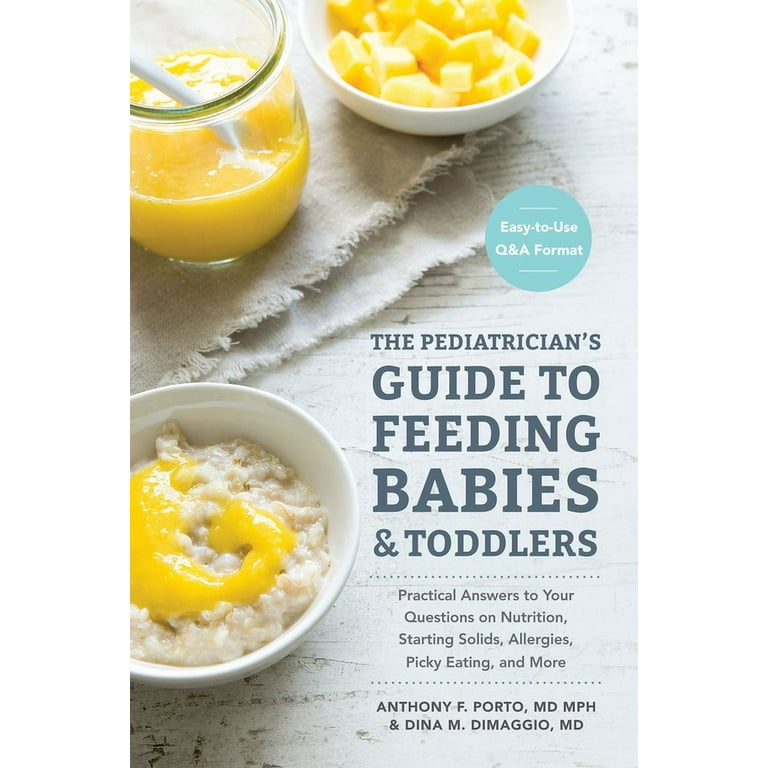Introducing solid foods to a picky eater baby can be challenging. Start with small portions of different types of foods to gauge their preferences.
When it comes to introducing solid foods to a picky eater baby, it can be a daunting task for many parents. However, with some tips and tricks, it can become an enjoyable experience for both you and your little one.
We will discuss various strategies and methods to make the transition to solid foods easier for your picky eater baby. Whether it’s introducing new flavors or textures, we’ve got you covered with practical advice to encourage your baby to develop healthy eating habits. With the right approach and patience, you can navigate this phase smoothly and set the foundation for a lifetime of healthy eating for your baby.

Credit: www.amazon.com
1. Introduction To Introducing Solid Foods
Introducing solid foods to a picky eater baby can be a challenging but important milestone in their development. When it comes to infants, the transition from a solely liquid diet to solids is a crucial step that requires patience and understanding. Many parents may encounter setbacks when trying to introduce new foods to their little ones, but with the right approach, it is possible to navigate this process successfully.
1.1 Benefits Of Introducing Solid Foods
Introducing solid foods into a baby’s diet not only provides essential nutrients but also helps in developing their palate and motor skills. By exposing them to a variety of tastes and textures early on, you can instill healthy eating habits that can last a lifetime. Additionally, introducing solids can fulfill a baby’s increased nutritional requirements as they grow beyond the initial months.
1.2 Challenges With A Picky Eater Baby
Dealing with a picky eater baby can be frustrating for parents, as they may resist trying new foods or exhibit strong preferences for certain tastes and textures. This can lead to concerns about inadequate nutrition and growth. Understanding the reasons behind picky eating behavior and finding effective strategies to overcome it is crucial for ensuring the child’s overall well-being.
2. Preparing For The Journey
Get the best tips for introducing solid foods to your picky eater baby and ensure a smooth journey. Prepare yourself with strategies to overcome feeding challenges and make mealtime enjoyable for your little one.
2.1 Timing: When To Start
Timing is crucial when initiating your baby’s solid food journey. Most pediatricians recommend starting between 4 to 6 months of age, when the baby shows signs of readiness, such as good head control and the ability to sit upright with support.
2.2 Types Of Foods To Introduce First
Opt for single-ingredient purees like mashed avocado, sweet potato, or banana. These foods are gentle on the stomach and provide essential nutrients needed for growth and development.
2.3 Equipment Needed
Basic items like a small baby spoon, a soft-tipped beginner’s bowl, and a high chair with proper support are essential for this phase. These tools enable a comfortable and safe feeding environment for your little one.
3. Creating A Positive Environment
Nurturing a positive environment during mealtimes can make a significant difference in how your picky eater baby approaches solid foods. By implementing a few simple strategies, you can turn mealtimes into an enjoyable and stress-free experience.
3.1 Making Mealtime Fun
Encourage your baby’s interest in solid foods by making mealtime a fun and interactive experience. Incorporate colorful plates, bowls, and utensils to captivate their attention and make the meal more visually appealing. Sing songs, play gentle music, or provide toys that are safe for them to explore while they eat. These playful additions can help create a positive association with food and make your little one more enthusiastic at mealtime.
3.2 Establishing A Routine
A consistent mealtime routine can provide structure and familiarity, which can be comforting for your picky eater baby. Set fixed meal and snack times to establish predictable expectations. Stick to these designated times as much as possible to help regulate your baby’s hunger patterns and avoid prolonged periods without eating. Routine can help create a sense of security and make mealtimes feel less overwhelming for your little one.
3.3 Being A Role Model
Your baby looks up to you as their role model, and this extends to the way they explore and try new foods. Show enthusiasm and curiosity when introducing new flavors and textures. Let them see you enjoying a variety of healthy foods during family meals. By modeling positive eating behaviors, you can inspire your baby to follow suit and be more open to trying new foods.
3.4 Minimizing Distractions
To help your picky eater baby focus on the meal at hand, minimize distractions during mealtimes. Turn off the television and put away electronic devices to ensure their attention remains on the food in front of them. Create a calm and quiet environment to enhance their sensory experience of taste and texture. By reducing external stimuli, you can help your baby become more mindful of their food and increase their willingness to explore new flavors.

Credit: www.firstfiveyears.org.au
4. Dealing With Picky Eating Behaviors
Introducing solid foods to a picky eater baby can be a challenge, but with the right approach, you can make the experience more enjoyable for both you and your little one. In this section, we will discuss some effective tips for dealing with picky eating behaviors. From understanding picky eating to exploring different textures and flavors, we have got you covered.
4.1 Understanding Picky Eating
Understanding picky eating is crucial when it comes to introducing solid foods to your baby. It is important to know that picky eating is a normal part of a child’s development. Some babies may take longer to accept new foods or may have strong food preferences. By recognizing and accepting this, you can approach feeding your picky eater baby with patience and understanding.
4.2 Trying Different Textures And Flavors
Trying different textures and flavors is key to expanding your picky eater baby’s palate. Give your baby a variety of foods with different textures, such as mashed, pureed, or soft foods. Explore different flavors by introducing a wide range of fruits, vegetables, and protein sources. Start with small portions and gradually increase the quantity as your baby becomes more comfortable with different tastes and textures.
4.3 Encouraging Self-feeding
Encouraging self-feeding can help your picky eater baby develop a positive relationship with food. Offer finger foods that are easy to grasp, allowing your baby to explore and feed themselves. This not only promotes independence but also helps with the development of fine motor skills. Allow your baby to take control of their eating experience, even if it means a bit more mess at first.
4.4 Involving Your Baby In Meal Preparation
Involving your baby in meal preparation can spark their interest in food and make them more willing to try new things. Let them accompany you to the grocery store, and show them the different fruits, vegetables, and other ingredients. Allow them to help with simple tasks like washing fruits or stirring ingredients. This not only introduces them to various foods but also gives them a sense of pride and ownership over their meals.
By following these tips, you can navigate the challenges of introducing solid foods to your picky eater baby with confidence. Remember to be patient, provide a variety of textures and flavors, encourage self-feeding, and involve your baby in meal preparation. With time and persistence, your little one will develop a healthy relationship with food and embrace new tastes and textures.
5. Troubleshooting Common Issues
Introducing solid foods to a picky eater baby can come with its fair share of challenges. Luckily, there are solutions to common issues that can arise during this journey. In this section, we will discuss some troubleshooting tips to help you navigate food allergies and intolerances, manage spit-ups and gagging, address digestive problems, and seek professional advice.
5.1 Food Allergies And Intolerances
Allergies and intolerances can make introducing solid foods even more challenging. To identify potential food allergens, keep a detailed record of what you feed your baby and any reactions they might have. Consult with your pediatrician for guidance and consider introducing new foods one at a time, waiting a few days between each new food to monitor for any adverse reactions. Common food allergens to watch out for include:
| Common Food Allergens | Signs of Allergic Reaction |
|---|---|
| Milk | Rash, hives, vomiting, diarrhea |
| Eggs | Rash, hives, swelling, difficulty breathing |
| Wheat | Stomach pain, bloating, diarrhea |
| Soy | Rash, hives, vomiting, diarrhea |
5.2 Managing Spit-ups And Gagging
Spit-ups and gagging are common occurrences when introducing solid foods. To manage these issues, consider the following tips:
- Feed your baby in an upright position to reduce the chance of spit-ups.
- Offer smaller, more frequent meals to prevent overfeeding and reduce the likelihood of gagging.
- Choose softer food textures initially to minimize the risk of choking.
- Stay calm if your baby experiences gagging, as reassuring them can help them feel more comfortable.
5.3 Addressing Digestive Problems
Digestive problems like constipation or diarrhea can disrupt the introduction of solid foods. To address these issues:
- Ensure your baby is receiving enough fluids, as dehydration can lead to constipation.
- Incorporate high-fiber foods into their diet, such as fruits, vegetables, and whole grains.
- Limit foods that are known to cause gas, such as beans, broccoli, and cabbage.
- If digestive problems persist, consult with your pediatrician for further guidance.
5.4 Seeking Professional Advice
If you’re facing persistent challenges or have concerns about your baby’s eating habits, seeking professional advice is essential. Your pediatrician can provide personalized guidance and address any underlying issues your picky eater may have. Don’t hesitate to reach out for support and expert recommendations.

Credit: www.walmart.com
Frequently Asked Questions Of Tips For Introducing Solid Foods To A Picky Eater Baby
How Do You Introduce Food To A Picky Baby?
Introduce new foods one at a time. Be patient and offer small portions. Make mealtime fun. Don’t force, but keep offering. Stick with it, and don’t give up.
What Is The 3 Day Rule For Introducing Solids?
The 3 day rule for introducing solids means giving a new food for at least 3 days to check for any allergic reactions or sensitivity in babies.
What Are 2 Tips For Introducing Solid Foods For Babies?
Introduce solid foods gradually, starting with pureed fruits or vegetables. Offer one new food at a time to watch for any allergies or reactions. As babies may initially reject new flavors, keep offering the food to build their acceptance.
How Do You Start A Solid Picky Eater?
To help a picky eater, introduce new foods gradually, be patient, and make mealtime enjoyable. Offer a variety of healthy options, involve them in grocery shopping and cooking, and set a positive example by eating together as a family. Add unfamiliar foods alongside familiar ones and let the child explore and try at their own pace.
Conclusion
To successfully introduce solid foods to your picky eater baby, patience and persistence are key. Start by offering a variety of textures and flavors, gradually increasing the complexity of their meals. Consistency is essential, as is creating a positive mealtime environment.
Remember, every baby is different, so don’t get discouraged if they don’t immediately take to certain foods. With time and a little creativity, you’ll find the right balance that will help your baby develop healthy eating habits for life.











